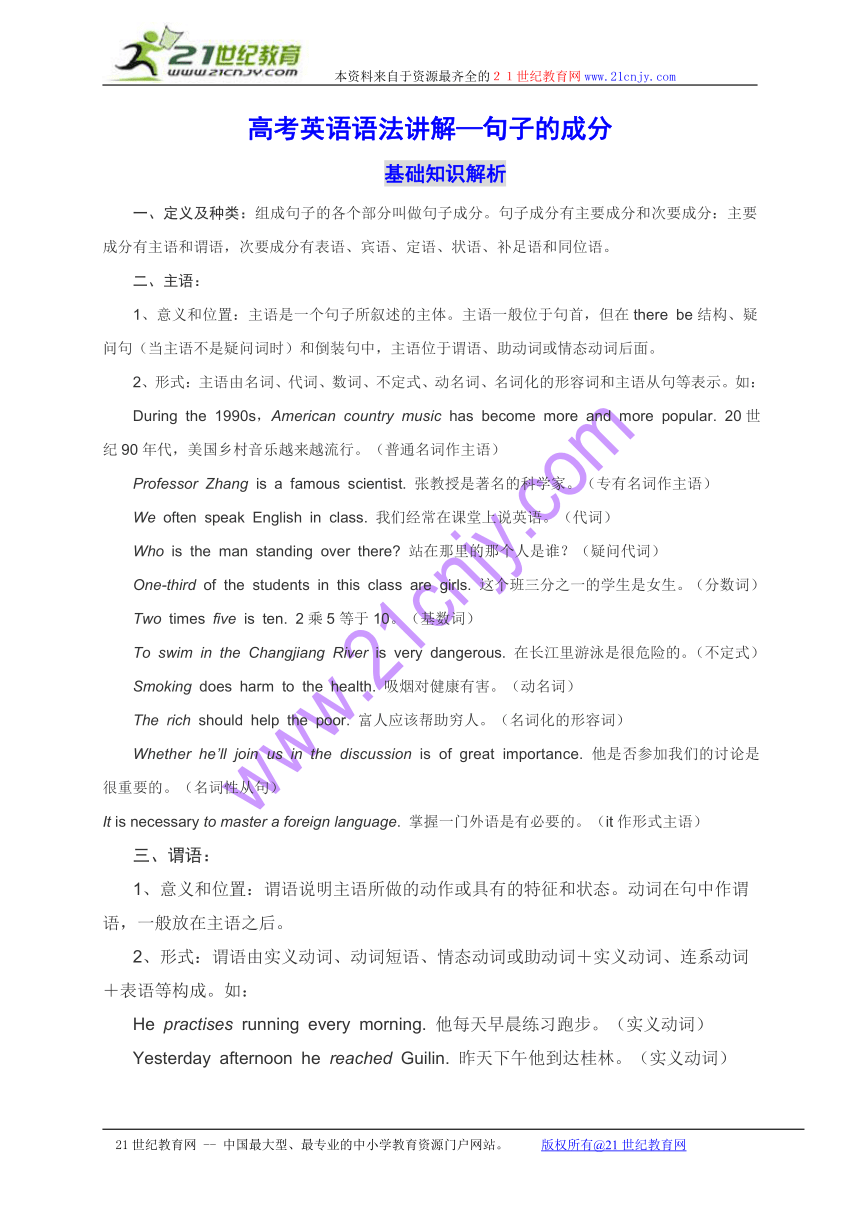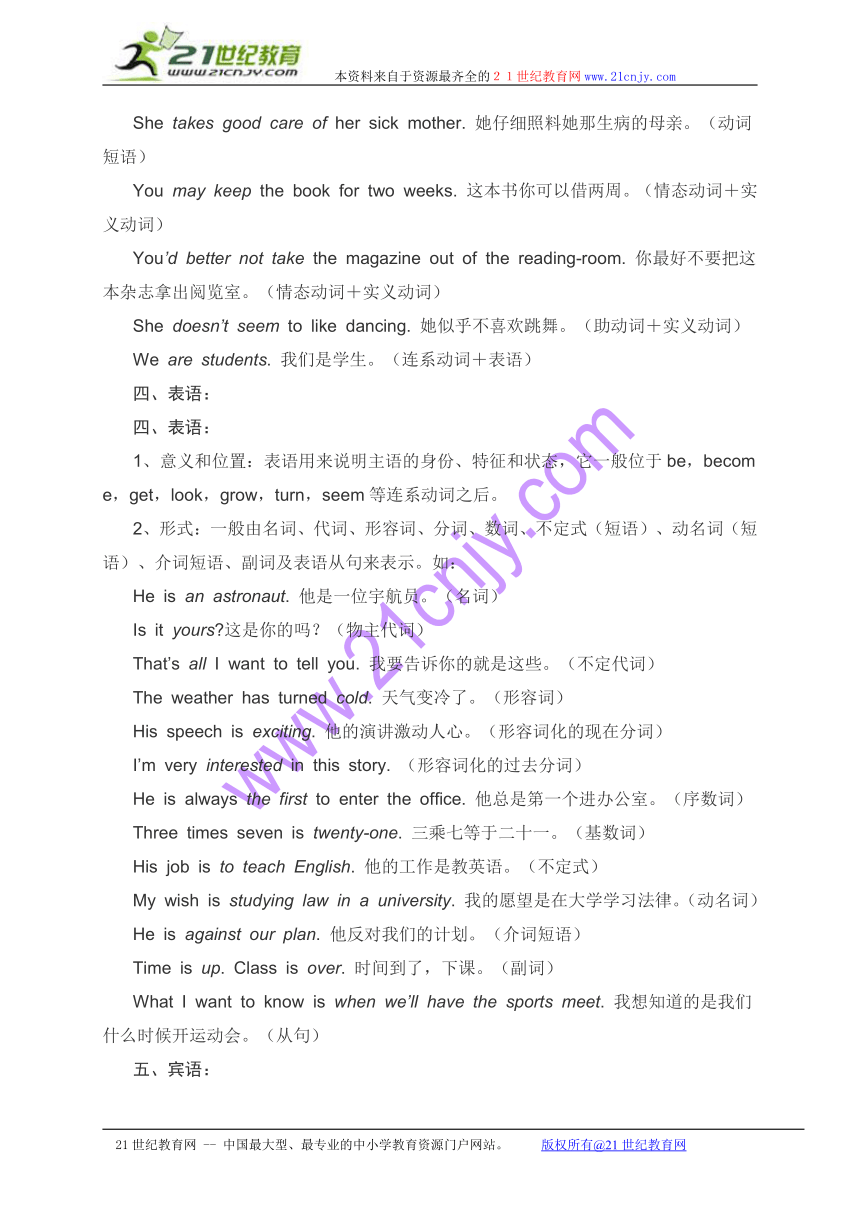高考英语语法讲解—句子的成分
图片预览



文档简介
本资料来自于资源最齐全的21世纪教育网www.21cnjy.com
高考英语语法讲解—句子的成分
基础知识解析
一、定义及种类:组成句子的各个部分叫做句子成分。句子成分有主要成分和次要成分:主要成分有主语和谓语,次要成分有表语、宾语、定语、状语、补足语和同位语。
二、主语:
1、意义和位置:主语是一个句子所叙述的主体。主语一般位于句首,但在there be结构、疑问句(当主语不是疑问词时)和倒装句中,主语位于谓语、助动词或情态动词后面。
2、形式:主语由名词、代词、数词、不定式、动名词、名词化的形容词和主语从句等表示。如:
During the 1990s,American country music has become more and more popular. 20世纪90年代,美国乡村音乐越来越流行。(普通名词作主语)
Professor Zhang is a famous scientist. 张教授是著名的科学家。(专有名词作主语)
We often speak English in class. 我们经常在课堂上说英语。(代词)
Who is the man standing over there 站在那里的那个人是谁?(疑问代词)
One-third of the students in this class are girls. 这个班三分之一的学生是女生。(分数词)
Two times five is ten. 2乘5等于10。(基数词)
To swim in the Changjiang River is very dangerous. 在长江里游泳是很危险的。(不定式)
Smoking does harm to the health. 吸烟对健康有害。(动名词)
The rich should help the poor. 富人应该帮助穷人。(名词化的形容词)
Whether he’ll join us in the discussion is of great importance. 他是否参加我们的讨论是很重要的。(名词性从句)
It is necessary to master a foreign language. 掌握一门外语是有必要的。(it作形式主语)
三、谓语:
1、意义和位置:谓语说明主语所做的动作或具有的特征和状态。动词在句中作谓语,一般放在主语之后。
2、形式:谓语由实义动词、动词短语、情态动词或助动词+实义动词、连系动词+表语等构成。如:
He practises running every morning. 他每天早晨练习跑步。(实义动词)
Yesterday afternoon he reached Guilin. 昨天下午他到达桂林。(实义动词)
She takes good care of her sick mother. 她仔细照料她那生病的母亲。(动词短语)
You may keep the book for two weeks. 这本书你可以借两周。(情态动词+实义动词)
You’d better not take the magazine out of the reading-room. 你最好不要把这本杂志拿出阅览室。(情态动词+实义动词)
She doesn’t seem to like dancing. 她似乎不喜欢跳舞。(助动词+实义动词)
We are students. 我们是学生。(连系动词+表语)
四、表语:
四、表语:
1、意义和位置:表语用来说明主语的身份、特征和状态,它一般位于be,become,get,look,grow,turn,seem等连系动词之后。
2、形式:一般由名词、代词、形容词、分词、数词、不定式(短语)、动名词(短语)、介词短语、副词及表语从句来表示。如:
He is an astronaut. 他是一位宇航员。(名词)
Is it yours 这是你的吗?(物主代词)
That’s all I want to tell you. 我要告诉你的就是这些。(不定代词)
The weather has turned cold. 天气变冷了。(形容词)
His speech is exciting. 他的演讲激动人心。(形容词化的现在分词)
I’m very interested in this story. (形容词化的过去分词)
He is always the first to enter the office. 他总是第一个进办公室。(序数词)
Three times seven is twenty-one. 三乘七等于二十一。(基数词)
His job is to teach English. 他的工作是教英语。(不定式)
My wish is studying law in a university. 我的愿望是在大学学习法律。(动名词)
He is against our plan. 他反对我们的计划。(介词短语)
Time is up. Class is over. 时间到了,下课。(副词)
What I want to know is when we’ll have the sports meet. 我想知道的是我们什么时候开运动会。(从句)
五、宾语:
1、意义和位置:宾语表示动作的对象或承受,位于及物动词、介词后面。
2、形式:宾语由名词、代词、数词、名词化的形容词或分词、不定式(短语)、动名词(短语)、从句等。如:
He is going to buy a dictionary. 他打算买本字典。(名词)
We should learn from him. 我们应该向他学习。(代词)
—How many dictionaries do you have 你有几本字典?—I have five. 我有5本。(数词)
They helped the old with their housework yesterday. 他们昨天帮助老年人做家务。(名词化的形容词)
We should take the wounded to the hospital immediately. 我们应该立刻把伤员送到医院去。(名词化的分词)
He pretended not to see me. 他假装没有看见我。(不定式)
I enjoy listening to popular music. 我喜欢听流行音乐。(动名词)
I think that he is fit for his office. 我认为他称职。(从句)
3、种类:
(1)直接宾语:表示动作的承受者或结果,通常指物。如:
Excuse me,please. Could you tell me the way to the railway station 对不起,请问到火车站怎么走?(直接宾语)
(2)间接宾语:表示动作所向的或所为的人或物,通常指人。一般位于直接宾语之前。如果位于直接宾语之后,多数情况下应在它的前面加上介词to。如:
The company sent us a few computers last year.
=The company sent a few computers to us last year. 公司去年给我们送了几台计算机。
(3)复合宾语:即宾语+宾语补足语。宾语与宾语补足语一起称为复合宾语,它们在逻辑上有主谓关系。如果宾语是不定式、动名词(短语)或从句,常用it作形式宾语,实际宾语放在补足语之后。如:
They elected him their monitor. 他们选他当班长。(代词+名词)
I found the baby always happy. 我发现这个婴儿总是很愉快的。(名词+形容词)
The next day he found himself in the hospital when he waked. 当他第二天醒来时发现自己在医院里。(代词+介词短语)
I often ask him to help me with my English. 我经常请他帮助我学英语。(代词+不定式)
I find it easy to answer this question. 我发现回答这个问题很容易。(it作形式宾语)
(4)介词宾语:位于介词后面的宾语称为介词宾语。如:
In our school about three-fourths of the students are from the north. 我们学校四分之三的学生来自北方。
六、宾语补足语:
1、意义和位置:宾语补足语,用来说明宾语是什么或怎么样,放在宾语之后,和宾语一起称为复合宾语。
2、形式:由名词、形容词或形容词短语、不定式(短语)、现在分词(短语)、过去分词(短语)、介词短语、副词、从句等。如:
His father named him Jack. 他父亲给他取名杰克。(名词)
They painted their boat white. 他们把船漆成白色。(形容词)
Nobody noticed him enter the room. 没有人注意到他进了屋子。(不定式短语)
You mustn’t force him to lend his money to you. 你不应该强迫他借钱给你。(不定式短语)
〖注〗see,have,let,make,watch,notice,hear,observe等动词后的宾语补足语用不定式表示时,不可加to。help后的不定式可带可不带to。如:
I heard him singing an English song in the next room. 我听见她在隔壁房间唱着英语歌。(现在分词短语)
They found the Three Gorges greatly changed. 他们发现三峡变化巨大。(过去分词短语)
I looked upon him as my best friend. 我把他认作我的最好的朋友。(介词短语)
Whenever you may go,you will find him at work. 不论什么时候去,你都可以看见他在工作。(介词短语)
Let him in. 让他进来吧。(副词)
We will soon make our country what the developed countries are now. 我们很快就会把我们的国家建设成为发达国家现在的样子。(从句)
〖注〗谓语动词think,find,consider,judge,feel,make,take等后面的复合宾语中常用it作形式宾语,而把实际宾语放在补足语之后。如:
They thought it right to do this test. 他们原先认为做这项试验是对的。
We all consider it our duty that we should support him. 我们都把支持他看作我们的职责。
We feel it necessary to learn a foreign language well. 我们感觉得学好一门外语是必要的。
七、定语:
1、意义:修饰名词或代词的词、短语或从句称为定语。
2、位置:形容词一般置于所修饰的词前,但修饰不定代词时后置。enough可前置,也可后置。副词作定语后置。短语和从句作定语时后置。单个现在分词和过去分词作定语时前置。
3、形式:由形容词、冠词、分词(短语)、名词、代词、数词、名词所有格、不定式、动名词、介词短语、副词和定语从句等充当。如:
Wuhan is a big city. 武汉是一个大城市。(冠词、形容词前置)
I have something important to tell you. 我有重要的事情告诉你。(形容词修饰不定代词后置)
He has enough time / time enough to do the job. 他有足够的时间来做这事儿。(enough作定语)
Those women doctors are very strict in their work. 那些女医生对工作很负责。(指示代词、名词、物主代词前置)
It is a shoe factory. 那是一家鞋厂。(名词前置)
China is a developing country,while America is a developed country. 中国是个发展中国家,而美国是发达国家。(现在分词、过去分词前置)
Who is the man shaking hands with our teacher 和我们老师握手的那个人是谁?(分词短语后置)
More than thirty students in our class have read the book. 我们班三十多个学生读过这本书。(基数词前置)
Let’s come to the first lesson. 咱们上第一课吧。(序数词前置)
Peter has gone to the tailor’s shop. 彼得去了裁缝店。(名词所有格前置)
I can’t go with you. I still have a lot of work to do. 我不能和你去。我仍有许多工作要做。(不定式后置)
You mustn’t take the magazine out of the reading room. 你不要把杂志带出阅览室。(动名词前置)
Who is the girl in red 穿红衣服的那个姑娘是谁?(介词短语后置)
The man in the room below is friendly. 楼下房间里的那人很友好。(副词后置)
I will always remember the day when I first met her. 我将永远记得我第一次见到他的那一天。(定语从句后置)
八、状语:
1、意义:修饰动词、形容词、副词或整个句子,说明动作或状态特征的句子成分,叫做状语。
2、形式:状语由副词、介词短语、不定式(短语)、分词(短语)、名词(短语)、形容词短语、状语从句等充当。如:
Light travels most quickly. 光线传播最快。(副词)
Factories and buildings are seen here and there. 到处能见到工厂和建筑物。(副词词组)
I have lived in the city for twenty years. 我已在这座城市生活了二十年了。(介词短语)
The box is too heavy for me to carry. 这个箱子太重,我扛不动。(不定式)
She is in the next room singing and dancing. 她在隔壁房间里又是唱歌又是跳舞。(现在分词)
Encouraged by the teacher,I made up my mind to learn English well. 在老师的鼓励下,我决心把英语学好。(过去分词)
The playground is 200 metres long and 100 metres wide. 操场有200米长100米宽。(名词)
It is very difficult to live where there is little water. 在没有多少水的地方,生活是十分艰难的。(从句)
3、种类:状语分为时间状语、地点状语、原因状语、条件状语、方式状语、比较状语、目的状语、结果状语、让步状语、程度状语、伴随状语等。如:
How about meeting again at six 六点再见面怎样?(时间)
When it rains,I usually go to school by bus. 下雨天,我通常乘公共汽车去上学。(时间)
Mr Smith lives on the third floor. 史密斯先生住在三楼。(地点)
Last night she didn’t go to the dance party because of the rain. 由于下雨,她昨晚没有去参加舞会。(原因)
I shall go there if it doesn’t rain. 如果不下雨,我将到那里去。(条件)
She put the eggs into the basket with great care. 她小心地把鸡蛋放在篮子里。(方式)
She came in with a dictionary in her hand. 她进来时手里拿着一本字典。(伴随)
I went there to see a friend of mine. 我去那里看我的一个朋友。(目的)
He was so tired that he fell asleep immediately. 他累极了,立刻就睡着了。(结果)
She works very hard though she is old. 虽然她年纪大了,但她仍然十分努力工作。(让步)
They were greatly moved to hear the hero’s story. 听了英雄的故事,他们深受感动。(程度)
I am taller than he is. 我个子比他高。(比较)
21世纪教育网 -- 中国最大型、最专业的中小学教育资源门户网站。 版权所有@21世纪教育网
高考英语语法讲解—句子的成分
基础知识解析
一、定义及种类:组成句子的各个部分叫做句子成分。句子成分有主要成分和次要成分:主要成分有主语和谓语,次要成分有表语、宾语、定语、状语、补足语和同位语。
二、主语:
1、意义和位置:主语是一个句子所叙述的主体。主语一般位于句首,但在there be结构、疑问句(当主语不是疑问词时)和倒装句中,主语位于谓语、助动词或情态动词后面。
2、形式:主语由名词、代词、数词、不定式、动名词、名词化的形容词和主语从句等表示。如:
During the 1990s,American country music has become more and more popular. 20世纪90年代,美国乡村音乐越来越流行。(普通名词作主语)
Professor Zhang is a famous scientist. 张教授是著名的科学家。(专有名词作主语)
We often speak English in class. 我们经常在课堂上说英语。(代词)
Who is the man standing over there 站在那里的那个人是谁?(疑问代词)
One-third of the students in this class are girls. 这个班三分之一的学生是女生。(分数词)
Two times five is ten. 2乘5等于10。(基数词)
To swim in the Changjiang River is very dangerous. 在长江里游泳是很危险的。(不定式)
Smoking does harm to the health. 吸烟对健康有害。(动名词)
The rich should help the poor. 富人应该帮助穷人。(名词化的形容词)
Whether he’ll join us in the discussion is of great importance. 他是否参加我们的讨论是很重要的。(名词性从句)
It is necessary to master a foreign language. 掌握一门外语是有必要的。(it作形式主语)
三、谓语:
1、意义和位置:谓语说明主语所做的动作或具有的特征和状态。动词在句中作谓语,一般放在主语之后。
2、形式:谓语由实义动词、动词短语、情态动词或助动词+实义动词、连系动词+表语等构成。如:
He practises running every morning. 他每天早晨练习跑步。(实义动词)
Yesterday afternoon he reached Guilin. 昨天下午他到达桂林。(实义动词)
She takes good care of her sick mother. 她仔细照料她那生病的母亲。(动词短语)
You may keep the book for two weeks. 这本书你可以借两周。(情态动词+实义动词)
You’d better not take the magazine out of the reading-room. 你最好不要把这本杂志拿出阅览室。(情态动词+实义动词)
She doesn’t seem to like dancing. 她似乎不喜欢跳舞。(助动词+实义动词)
We are students. 我们是学生。(连系动词+表语)
四、表语:
四、表语:
1、意义和位置:表语用来说明主语的身份、特征和状态,它一般位于be,become,get,look,grow,turn,seem等连系动词之后。
2、形式:一般由名词、代词、形容词、分词、数词、不定式(短语)、动名词(短语)、介词短语、副词及表语从句来表示。如:
He is an astronaut. 他是一位宇航员。(名词)
Is it yours 这是你的吗?(物主代词)
That’s all I want to tell you. 我要告诉你的就是这些。(不定代词)
The weather has turned cold. 天气变冷了。(形容词)
His speech is exciting. 他的演讲激动人心。(形容词化的现在分词)
I’m very interested in this story. (形容词化的过去分词)
He is always the first to enter the office. 他总是第一个进办公室。(序数词)
Three times seven is twenty-one. 三乘七等于二十一。(基数词)
His job is to teach English. 他的工作是教英语。(不定式)
My wish is studying law in a university. 我的愿望是在大学学习法律。(动名词)
He is against our plan. 他反对我们的计划。(介词短语)
Time is up. Class is over. 时间到了,下课。(副词)
What I want to know is when we’ll have the sports meet. 我想知道的是我们什么时候开运动会。(从句)
五、宾语:
1、意义和位置:宾语表示动作的对象或承受,位于及物动词、介词后面。
2、形式:宾语由名词、代词、数词、名词化的形容词或分词、不定式(短语)、动名词(短语)、从句等。如:
He is going to buy a dictionary. 他打算买本字典。(名词)
We should learn from him. 我们应该向他学习。(代词)
—How many dictionaries do you have 你有几本字典?—I have five. 我有5本。(数词)
They helped the old with their housework yesterday. 他们昨天帮助老年人做家务。(名词化的形容词)
We should take the wounded to the hospital immediately. 我们应该立刻把伤员送到医院去。(名词化的分词)
He pretended not to see me. 他假装没有看见我。(不定式)
I enjoy listening to popular music. 我喜欢听流行音乐。(动名词)
I think that he is fit for his office. 我认为他称职。(从句)
3、种类:
(1)直接宾语:表示动作的承受者或结果,通常指物。如:
Excuse me,please. Could you tell me the way to the railway station 对不起,请问到火车站怎么走?(直接宾语)
(2)间接宾语:表示动作所向的或所为的人或物,通常指人。一般位于直接宾语之前。如果位于直接宾语之后,多数情况下应在它的前面加上介词to。如:
The company sent us a few computers last year.
=The company sent a few computers to us last year. 公司去年给我们送了几台计算机。
(3)复合宾语:即宾语+宾语补足语。宾语与宾语补足语一起称为复合宾语,它们在逻辑上有主谓关系。如果宾语是不定式、动名词(短语)或从句,常用it作形式宾语,实际宾语放在补足语之后。如:
They elected him their monitor. 他们选他当班长。(代词+名词)
I found the baby always happy. 我发现这个婴儿总是很愉快的。(名词+形容词)
The next day he found himself in the hospital when he waked. 当他第二天醒来时发现自己在医院里。(代词+介词短语)
I often ask him to help me with my English. 我经常请他帮助我学英语。(代词+不定式)
I find it easy to answer this question. 我发现回答这个问题很容易。(it作形式宾语)
(4)介词宾语:位于介词后面的宾语称为介词宾语。如:
In our school about three-fourths of the students are from the north. 我们学校四分之三的学生来自北方。
六、宾语补足语:
1、意义和位置:宾语补足语,用来说明宾语是什么或怎么样,放在宾语之后,和宾语一起称为复合宾语。
2、形式:由名词、形容词或形容词短语、不定式(短语)、现在分词(短语)、过去分词(短语)、介词短语、副词、从句等。如:
His father named him Jack. 他父亲给他取名杰克。(名词)
They painted their boat white. 他们把船漆成白色。(形容词)
Nobody noticed him enter the room. 没有人注意到他进了屋子。(不定式短语)
You mustn’t force him to lend his money to you. 你不应该强迫他借钱给你。(不定式短语)
〖注〗see,have,let,make,watch,notice,hear,observe等动词后的宾语补足语用不定式表示时,不可加to。help后的不定式可带可不带to。如:
I heard him singing an English song in the next room. 我听见她在隔壁房间唱着英语歌。(现在分词短语)
They found the Three Gorges greatly changed. 他们发现三峡变化巨大。(过去分词短语)
I looked upon him as my best friend. 我把他认作我的最好的朋友。(介词短语)
Whenever you may go,you will find him at work. 不论什么时候去,你都可以看见他在工作。(介词短语)
Let him in. 让他进来吧。(副词)
We will soon make our country what the developed countries are now. 我们很快就会把我们的国家建设成为发达国家现在的样子。(从句)
〖注〗谓语动词think,find,consider,judge,feel,make,take等后面的复合宾语中常用it作形式宾语,而把实际宾语放在补足语之后。如:
They thought it right to do this test. 他们原先认为做这项试验是对的。
We all consider it our duty that we should support him. 我们都把支持他看作我们的职责。
We feel it necessary to learn a foreign language well. 我们感觉得学好一门外语是必要的。
七、定语:
1、意义:修饰名词或代词的词、短语或从句称为定语。
2、位置:形容词一般置于所修饰的词前,但修饰不定代词时后置。enough可前置,也可后置。副词作定语后置。短语和从句作定语时后置。单个现在分词和过去分词作定语时前置。
3、形式:由形容词、冠词、分词(短语)、名词、代词、数词、名词所有格、不定式、动名词、介词短语、副词和定语从句等充当。如:
Wuhan is a big city. 武汉是一个大城市。(冠词、形容词前置)
I have something important to tell you. 我有重要的事情告诉你。(形容词修饰不定代词后置)
He has enough time / time enough to do the job. 他有足够的时间来做这事儿。(enough作定语)
Those women doctors are very strict in their work. 那些女医生对工作很负责。(指示代词、名词、物主代词前置)
It is a shoe factory. 那是一家鞋厂。(名词前置)
China is a developing country,while America is a developed country. 中国是个发展中国家,而美国是发达国家。(现在分词、过去分词前置)
Who is the man shaking hands with our teacher 和我们老师握手的那个人是谁?(分词短语后置)
More than thirty students in our class have read the book. 我们班三十多个学生读过这本书。(基数词前置)
Let’s come to the first lesson. 咱们上第一课吧。(序数词前置)
Peter has gone to the tailor’s shop. 彼得去了裁缝店。(名词所有格前置)
I can’t go with you. I still have a lot of work to do. 我不能和你去。我仍有许多工作要做。(不定式后置)
You mustn’t take the magazine out of the reading room. 你不要把杂志带出阅览室。(动名词前置)
Who is the girl in red 穿红衣服的那个姑娘是谁?(介词短语后置)
The man in the room below is friendly. 楼下房间里的那人很友好。(副词后置)
I will always remember the day when I first met her. 我将永远记得我第一次见到他的那一天。(定语从句后置)
八、状语:
1、意义:修饰动词、形容词、副词或整个句子,说明动作或状态特征的句子成分,叫做状语。
2、形式:状语由副词、介词短语、不定式(短语)、分词(短语)、名词(短语)、形容词短语、状语从句等充当。如:
Light travels most quickly. 光线传播最快。(副词)
Factories and buildings are seen here and there. 到处能见到工厂和建筑物。(副词词组)
I have lived in the city for twenty years. 我已在这座城市生活了二十年了。(介词短语)
The box is too heavy for me to carry. 这个箱子太重,我扛不动。(不定式)
She is in the next room singing and dancing. 她在隔壁房间里又是唱歌又是跳舞。(现在分词)
Encouraged by the teacher,I made up my mind to learn English well. 在老师的鼓励下,我决心把英语学好。(过去分词)
The playground is 200 metres long and 100 metres wide. 操场有200米长100米宽。(名词)
It is very difficult to live where there is little water. 在没有多少水的地方,生活是十分艰难的。(从句)
3、种类:状语分为时间状语、地点状语、原因状语、条件状语、方式状语、比较状语、目的状语、结果状语、让步状语、程度状语、伴随状语等。如:
How about meeting again at six 六点再见面怎样?(时间)
When it rains,I usually go to school by bus. 下雨天,我通常乘公共汽车去上学。(时间)
Mr Smith lives on the third floor. 史密斯先生住在三楼。(地点)
Last night she didn’t go to the dance party because of the rain. 由于下雨,她昨晚没有去参加舞会。(原因)
I shall go there if it doesn’t rain. 如果不下雨,我将到那里去。(条件)
She put the eggs into the basket with great care. 她小心地把鸡蛋放在篮子里。(方式)
She came in with a dictionary in her hand. 她进来时手里拿着一本字典。(伴随)
I went there to see a friend of mine. 我去那里看我的一个朋友。(目的)
He was so tired that he fell asleep immediately. 他累极了,立刻就睡着了。(结果)
She works very hard though she is old. 虽然她年纪大了,但她仍然十分努力工作。(让步)
They were greatly moved to hear the hero’s story. 听了英雄的故事,他们深受感动。(程度)
I am taller than he is. 我个子比他高。(比较)
21世纪教育网 -- 中国最大型、最专业的中小学教育资源门户网站。 版权所有@21世纪教育网
